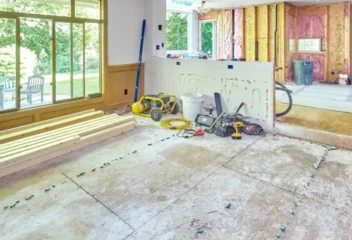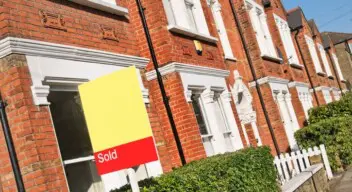What does retrofitting your home mean?
Retrofitting your home with energy efficiency upgrades is a process where homeowners and landlords look to reduce their property’s bills, carbon emissions and improve their home’s comfort. This is done by improving the existing fabrics of the house like double glazing and insulation, installing new energy efficiency measures like draught excluders and energy efficient lighting and by switching to cleaner energy sources like heat pumps and solar panels. These changes not only impact your experience of the home, but also improve the value of the property too.
How does retrofitting add value?
Incorporating energy-efficiency upgrades in your home adds value because it automatically lowers the operational costs of the property, so retrofitting your home is worth the investment.
Rightmove claims that improving the energy rating performance of your home from the UK average of a D rating to a C rating, the government’s potential target for all homes over the next decade, should add 4% to the value of your home. And if you’re improving your home from an E to a C you can add 16% to its value.
Last year Rightmove reported that homeowners were banking as much as 16% more on average on their home by making them more energy efficient. And as the housing market slows down it appears that homes with high energy ratings are holding their value.
Higher energy ratings for houses are becoming increasingly important to buyers as the cost of energy has increased, and sellers are now attaching premiums to their homes if they have ratings over C.
If you’d like to get a full breakdown of what your home needs to improve its energy efficiency, reduce its running costs and see the impact it has on your house value then you can book a home assessment with Furbnow. Book a home assessment here.
Future-proofing your home
Improving your energy rating now also means you’ll be on the front-foot as the government works towards its net zero goal. As a part of this, the government is consulting on whether by 2030 all houses have to have an energy rating of C and right now the average rating is D. You can find your home’s energy rating on the government website. A huge amount of work is going to need to be done to get all UK houses up to a rating of C and above.
How to reduce your bills, carbon footprint and improve your home’s comfort
As the saying goes, the cheapest energy is that which you don’t use. The most apparent financial benefit homeowners see in retrofitting to improve their home’s energy efficiency is the reduction in their energy bills, which, with the increasing cost of energy, has become an increasingly attractive option.
An example of how much homeowners can save on bills is that those with EPC level A and B homes can expect to save more than £3,100 per year in energy bills (after the April 2023 energy price cap rise) versus those with C and below. Per month energy efficient households can expect to save around £260. This does require significant investment in your home, with only 4% of older houses making the cut for the B and above energy rating. There are financial schemes available however which you can read more about in Furbnow’s article here.
These energy efficiency improvements can include:
- Installing double or triple glazing
- Installing cavity wall insulation
- Installing external wall insulation
- Installing internal wall insulation
- Installing underfloor heating
- Reducing draughts using sealant around windows and doors
- Installing energy efficient lighting
- Installing solar panels
- Installing a heat pump
When you are retrofitting your home with energy efficient measures, you’re essentially addressing any potential issues before they can become widespread problems. Be that avoiding damp through better ventilation or avoiding damaging your window frames by fitting double glazing. In doing so, you can dodge future repairs and save yourself some money.
Here are a few examples of how that works:
- Upgrading your heating, ventilation and air conditioning systems: If your boiler breaks down in the middle of winter or your piping comes apart from age you can end up spending a lot of money fixing the issue. By upgrading these in advance you can avoid shortcomings like this, as well as reducing your bills.
- Sealing air leaks: A draughty home won’t just give you chills and pose health concerns but the spread of damp and mould can be costly to repair especially if it works its way into the foundations and structure of your home.
- Upgrading your electrical systems: old and inefficient electrical systems can be costly to replace and also pose fire and other safety hazards. As part of your home upgrades, having an electrician look at your electric setup can help you understand the need to upgrade. Nothing worse than the lights going out every time you put the toaster on.
- Getting all jobs done at once. We’d always recommend a whole-house approach to retrofitting your property, you can save on bulk buying and is less disruptive having the builders in just the once.
Home improvements that improve energy efficiency
If you have a big home improvement in mind, it’s worth considering how retrofitting can help to enhance the energy efficiency of your home at the same time.
Here’s 5 ways energy upgrades can fit with other renovations:
1. Consider a heat pump – If you’re looking to replace your radiators then you should consider getting a heat pump. You’re already getting the hard work of changing all the piping around your home done why not use a more efficient, clean source of energy
2. Fit solar panels on your new extension – if you’re building a new extension chances are you want it to be full of natural light, in which case why not harness that light to lower your bills (or even make you money if you sell the energy to the grid).
3. Replace your windows with double or triple glazing – if you’re doing some wholesale changes then you could consider upgrading your windows which can lose a huge amount of energy if old or faulty.
4. Cavity wall insulation for your attic conversion – a really easy change you can make yourself is to buy and install insulation to go in the gaps in your walls. Not just if you extend the house but in any walls for that matter.
5. Solar battery storage for your EV – The dream set up, you take in the sun’s energy, save it in your battery, and then whenever you need it you can charge your car without it affecting your bills.
You can buy a Furbnow homebuyer retrofit report here, where an experienced surveyor will assess the property, so that you know exactly what you’re getting into before you move in.
How Furbnow can help
Homeowners are confused. They don’t know where to start or how best to invest in their home to reduce their energy bills and carbon footprint. This is why we founded Furbnow: to give impartial, actionable advice, and retrofitting your home with the work it actually needs.
If you’re looking for support with an ongoing project we can help with that too from DIY tips to project management, just get in touch.
Get the plan your home needs
Furbnow’s Home Energy Plan allows you to plan a retrofitting path forward for your property. You will get:
- A full overview of the current performance and how it could improve
- A detailed breakdown of potential problem areas in your home and the next steps for your project if you decide to start your retrofit.
- An outline of the outcomes the project will bring to your home as well as a breakdown of all the energy efficient measures you could install and the best measures to invest in first.
If you’d like to get a full breakdown of what your home needs to improve its energy efficiency, reduce its running costs and see the impact it has on your house value, then you can book a home assessment with Furbnow. Book a home assessment here.





 October 30, 2025
October 30, 2025 


